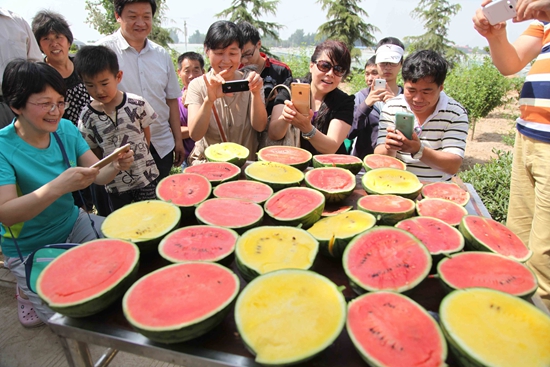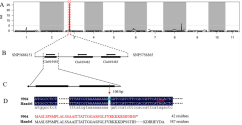The Genetic Mechanism of Three Important Agronomic Traits of Watermelon Was Revealed
Recently, the watermelon and melon cultivation and physiology team of Zhengzhou Fruit Research Institute of CAAS has made progress in localizing important agronomic traits in watermelon. The important functional genes of watermelon skin color, seed coat color, and internode length were studied and analyzed, the genetic and molecular mechanisms were elucidated, and related molecular markers were developed. These results provided a theoretical basis for watermelon molecular breeding, which could improve watermelon breeding in China. The related research results were published in the journals of Theoretical and Applied Genetics、Frontiers in Plant Science, and International Journal of Molecular Sciences.

China is the largest watermelon producer in the world. Skin color, seed coat color and internode length are agronomic traits with important economic significance in watermelon breeding. These traits play a positive role in improving watermelon quality and yield and in reducing cultivation and management cost. The genes controlling these three traits were successfully located in the hybrid isolation population. The results showed that the skin color of watermelon was controlled by a single gene, and dark green was dominant over light green. This gene was located on chromosome 8 and was ClCG08G017810 (encoding 2-phenyl-1, 4--naphthoquinone methyltransferase protein). The gene controlling watermelon seed coat color was Cla019481 on chromosome 3 (encoding polyphenol oxidase protein, which was involved in the synthesis of melanin), the black seed coat was dominant over the light yellow seed coat. The gene that controlled internode length (long versus short was dominant) was Cla015407 (encoding the protein gibberellin 3 -hydroxylase) on chromosome 9. Then the regulatory mechanism and molecular genetic mechanism of these three traits were revealed by qRT-PCR and related physiological experiments.
These researches were funded by the Agricultural Science and Technology Innovation Program(CAAS-ASTIP-2016-ZFRI-07), National Key R&D Program of China (2018YFD0100704), the China Agriculture Research System (CARS-25-03), and the National Nature Science Foundation of China (31672178 and 31471893).
More details are available at the links below:
https://www.frontiersin.org/articles/10.3389/fpls.2019.01689/full
https://link.springer.com/article/10.1007/s00122-019-03384-3
http://www.mdpi.com/1422-0067/21/1/290

Figure 1 Genetic mapping of the rind color gene and candidate gene analysis in watermelon

Figure 2 Genetic mapping of the short internode gene and candidate gene analysis in watermelon

Figure 3 Genetic mapping of the seed coat color gene and candidate gene analysis in watermelon
By Wenge Liu (liuwenge@caas.cn)
-
 Apr 18, 2024Opening Ceremony of the Training Workshop on Wheat Head Scab Resistance Breeding and Pest Control in Africa Held in CAAS
Apr 18, 2024Opening Ceremony of the Training Workshop on Wheat Head Scab Resistance Breeding and Pest Control in Africa Held in CAAS -
 Apr 03, 2024IPPCAAS Co-organized the Training Workshop on Management and Application of Biopesticides in Nepal
Apr 03, 2024IPPCAAS Co-organized the Training Workshop on Management and Application of Biopesticides in Nepal -
 Mar 28, 2024Delegation from the School of Agriculture and Food Science of University College Dublin, Ireland Visit to IAS, CAAS
Mar 28, 2024Delegation from the School of Agriculture and Food Science of University College Dublin, Ireland Visit to IAS, CAAS -
 Mar 25, 2024Director of World Food Prize Foundation visited GSCAAS
Mar 25, 2024Director of World Food Prize Foundation visited GSCAAS -
 Mar 20, 2024Institute of Crop Sciences (ICS) and Syngenta Group Global Seeds Advance Collaborative Research in the Seed Industry
Mar 20, 2024Institute of Crop Sciences (ICS) and Syngenta Group Global Seeds Advance Collaborative Research in the Seed Industry
